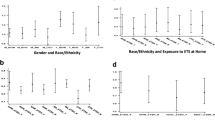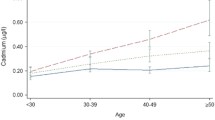Abstract
Objective: To examine if cigarette smoking will induce elevation in cadmium (Cd) in urine. Methods: Information on smoking habits, and urinary levels of cadmium (Cd-U), α1-microglobulin (α1-MG), β2-microglobulin (β2-MG), creatinine (CR or cr), and urine specific gravity (SG or sg) was cited from a combination of three previously established databases on adult Japanese women. After exclusion of those with unclear answers on smoking habits (412 cases), the combination (12,846 cases) gave 11,092, 1420 and 334 cases of never, current and former smokers, respectively, for present statistical analyses. Results: Multiple regression analyses taking Cd-U as a dependent variable and 11 regions of urine collection, age and smoking habits as independent variables showed that age and regions were powerful confounders in the analysis for the effects of smoking on Cd-U. To exclude the confounding effects, current and former smokers were paired with age- and region-matched never smoking controls in subsequent analyses. In addition, former smokers were paired with age- and region-matched current smokers. The comparison of the paired cases showed that Cd-U for current smokers was significantly higher than that for never smokers. The levels for former smokers were however not higher than the levels for never smokers. When classified by the number of cigarettes consumed per day, Cd-U for current smokers increased dependently to the number of cigarettes (about 0.09 μg/cigarette/day) with leveling off at 15 or more cigarettes. There was a subtle cigarette dose-dependent increase in α1-MG, but the increase was insignificant in case of β2-MG. Estimation of the amount of Cd absorbed due to cigarette smoking followed by comparison with the increase in Cd-U suggested that almost all Cd absorbed will be excreted into urine. Conclusions: Among currently smoking Japanese women, cadmium in urine increased in a manner dependent to the number of cigarettes consumed daily. Thus, smoking is a confounder of Cd-U evaluation even among the population with relatively high dietary Cd burden.

Similar content being viewed by others
References
Bache CA, Lisk DJ, Shane BS, Hoffmann D, Adams JD (1987) Effectiveness of cigarette filter tips for reducing cadmium in relation to other mainstream smoke constituents. Drug Chem Toxicol 10:189–193
Benedetti JL, Turcotte F, Lefebvre M, Therrien F, Weber JP (1992) Blood and urinary cadmium levels in Inuit living in Kuuijuaq, Canada. Sci Total Environ 127:167–172
Benedetti JL, Dewailly E, Turcotte F, Lefebvre M (1994) Unusually high blood cadmium associated with cigarette smoking among three subgroups of the general population, Quebec, Canada. Sci Total Environ 152:161–167
Cerna M, Spevackova V, Cejchanova M, Benes B, Rossner P, Bavorova H, Ocadlikova D, Smid J, Kubinova R (1997) Population-based biomonitoring in the Chech Republic—the system and selected results. Sci Total Environ 204:263–270
dell’Omo M, Muzi G, Piccinini R, Gambelunghe A, Morucci P, Tiziana F, Ambrogi M, Abritti G (1999) Blood cadmium concentrations in the general population of Umbria, Central Italy. Sci Total Environ 226:57–64
Elinder CG, Kjellstrom T, Lind B, Linnman L, Piscator M, Sundstedt K (1983) Cadmium exposure from smoking cigarettes; variations with time and country where purchased. Environ Res 32:220–227
Ellingsen DG, Thomassen Y, Aaseth J, Alexander J (1997) Cadmium and selenium in blood and urine related to smoking habits and previous exposure to mercury vapour. J Appl Toxicol 17:337–343
Ezaki T, Tsukahara T, Moriguchi J, Furuki K, Fukui Y, Ukai H, Okamoto S, Sakurai H, Honda S, Ikeda M (2003) Analysis for threshold levels of cadmium in urine that induce tubular dysfunction among women in non-polluted areas in Japan. Int Arch Occup Environ Health 76:197–204
Gairola CG, Wagner GJ (1991) Cadmium accumulation in the lung, liver and kidney of mice and rats chronically exposed to cigarette smoke. J Appl Toxicol 11:355–358
Hoffmann K, Becker K, Friedrich C, Helm D, Krause C, Seifert B (2000) The German Environmental Survey 1990/1992 (GerES II); cadmium in blood, urine and hair of adults and children. J Expo Anal Environ Epidemiol 10:126–13
Horiguchi H, Oguma E, Sasaki S, Miyamoto K, Ikeda Y, Machida M, Kayama F (2004a) Comprehensive study of the effects of age, iron deficiency, diabetes mellitus, and cadmium burden on dietary cadmium absorption in cadmium-exposed female Japanese farmers. Toxicol Appl Pharmacol 196:114–123
Horiguchi H, Oguma E, Sasaki S, Miyamoto K, Ikeda Y, Machida M, Kayama F (2004b) Dietary exposure to cadmium at close to the current provisional tolerable weekly intake does not affect renal function among female Japanese farmers. Environ Res 95:20–31
Hossny E, Mokhtar G, El-Awady M, Ali I, Morsy M, Dawood A (2001) Environmental exposure of the pediatric age groups in Cairo City and its suburbs to cadmium pollution. Sci Total Environ 273:135–146
Ikeda M (1992) Biological monitoring of the general population for cadmium. In : Nordberg GF, Herber RFM, Alessio L (ed) Cadmium in the human environment : toxicity and carcinogenicity. International Agency for Research on Cancer, Lyon, France, pp65–72
Ikeda M, Ezaki T, Tsukahara T, Moriguchi J (2004) Dietary cadmium intake in polluted and non-polluted areas in Japan in the past and in the present. Int Arch Occup Environ Health 77:227–234
Internatiomal Programme on Chemical Safety (1992a) Environmental Health Criteria 134. Cadmium. World Health Organization, Geneva
Internatiomal Programme on Chemical Safety (1992b) Environmental Health Criteria 135. Cadmium—environmental aspects. World Health Organization, Geneva
Jackson S (1966) Creatinine in urine as an index of urinary excretion rate. Health Phys 12:843–850
Kalcher K, Kern W, Pietsch R (1993) Cadmium and lead in the smoke of a filter cigarette. Sci Total Environ 128:21–35
Kasuya M, Aoshima K, Katoh T, Teranishi H, Horiguchi H, Kitagawa M, Hagino S (1992) Natural history of Itai-itai disease: a long-term observation on the clinical and laboratory findings in patients with Itai-itai disease. In: Cook ME, Hiscock SA, Morrow H, Volpe A (eds) Edited proceedings of the seventh international cadmium conference, New Orleans. Cadmium Association, London, pp180–192
Kowal NE (1988) Urinary cadmium and β2-microglobulin; correlation with nutrition and smoking history. J Toxicol Environ Health 25:179–183
Koyama H, Satoh H, Suzuki S, Tohyama C (1992) Increased urinary cadmium excretion and its relationship to urinary N-acetyl-β-D-glucosaminidase activity in smokers. Arch Toxicol 66:598–601
Levine L, Fahy JP (1945) Evaluation of urinary lead concentrations. I. The significance of the specific gravity. J Ind Hyg Toxicol 27:217–223
Mannino DM, Holguin F, Greves HM, Savage-Brown A, Stock AL, Jones RL (2004) Urinary cadmium levels predict lower lung function in current and former smokers; data from the third National Health and Nutrition Examination Survey. Thorax 59:194–198
Moriguchi J, Ezaki T, Tsukahara T, Furuki K, Fukui Y, Okamoto S, Ukai H, Sakurai H, Ikeda M (2005) α1-Microglobulin levels and correlation with cadmium and other metals in urine of non-smoking women among general populations in Japan. Toxicol Environ Chem (87:119-133)
Mortada WI, Sobh MA, El-Defrawy MM, Farahat SE (2002) Reference intervals of cadmium, lead, and mercury in blood, urine, hair, and nails among residents in Mansoura city, Nile delta, Egypt. Environ Res 90:104–110
Mortada WI, Sobh MA, El-Defrawy MM (2004) The exposure to cadmium, lead and mercury from smoking and its impact on renal integrity. Med Sci Monit 10:CR112–116
Nogawa K, Kido K, Yamada Y, Tsuritani I, Honda R, Ishizaki M, Terahata K (1984) α1-Microglobulin in urine as an indicator of renal tubular damage caused by environmental cadmium exposure. Toxicol Lett 22:63–68
Noonan CW, Sarasua SM, Campagna D, Kathman SJ, Lybarger JA, Mueller PW (2002) Effects of exposure to low levels of environmental cadmium on renal biomarkers. Environ Health Perspect 110:151–155
Paschal DC, Burt V, Caudill SP, Gunter EW, Pirkle JL, Sampson EJ, Miller DT, Jackson RJ (2000) Exposure of the U.S. population aged 6 years and older to cadmium; 1988–1994. Arch Environ Contam Toxicol 38:377–383
Rainsford SG, Lloyd Davies TA (1965) Urinary excretion of phenol by men exposed to vapour of benzene; a screening test. Br J Ind Med 22:21–26
Rickert WS, Kaiserman MJ (1994) Levels of lead, cadmium, and mercury in Canadian cigarette tobacco as indicators of environmental change: results from a 21-year study (1968–1988). Environ Sci Technol 28:924–927
Sartor FA, Rondia DJ, Claeys FD, Staessen JA, Lauwerys RR, Bernard AM, Buchet JP, Roels HA, Bruaux PJ, Ducoffre GM, Lijnen PJ, Thijs LB, Amery AK (1992) Impact of environmental cadmium pollution on cadmium exposure and body burden. Arch Environ Health 47:347–353
Shaham J, Meltzer A, Ashkenazi R, Ribak J (1996) Biological monitoring of exposure to cadmium, a human carcinogen, as a result of active and passive smoking. J Occup Environ Med 38:1220–1228
Sirivarasai J, Kaojaren S, Wananukul W, Srisomerang P (2002) Non-occupational determinants of cadmium and lead in blood and urine among general population in Thailand. Southeast Asian J Trop Med Publ Health 33:180–187
Suna S, Asakawa F, Jitsunari F, Manabe Y, Gotou A, Fukanaga I, Nakajima T (1991) Assessment of cadmium and lead released from cigarette smoke. Jpn J Hyg 46:1014–1024 (in Japanese with English abstract)
Tohyama C, Kobayashi E, Saito H, Sugihara N, Nakano A, Mitane Y (1986) Urinary α1-microglobulin as an indicator protein of renal tubular dysfunction caused by environmental cadmium exposure. J Appl Toxicol 6:171–178
Torrence KM, McDaniel RL, Self DA, Chang MJ (2002) Slurry sampling for the determination of arsenic, cadmium, and lead in mainstream cigarette smoke condensate by graphite furnace-atomic absorption spectrometry and inductively coupled plasma-mass spectrometry. Anal Bioanal Chem 372:723–731
Tsukahara T, Ezaki T, Moriguchi J, Furuki K, Fukui Y, Ukai H, Okamoto S, Sakurai H, Ikeda M (2003) No significant effect of iron deficiency on cadmium body burden or kidney dysfunction among women in the general population in Japan. Int Arch Occup Environ Health 76:275–281
Vivoli G, Bergomi M, Borella P, Fantuzzi G, Caselgrandi E (1989) Cadmium in blood, urine and hair related to human hypertension. J Trace Elem Electrolytes Health Dis 3:139–145
Watanabe T, Koizumi A, Fujita H, Fujimoto H, Ishimori A, Ikeda M (1982) Effects of aging and smoking on the cadmium levels in the blood of inhabitants in non-polluted areas. Tohoku J Exp Med 138:443–444
Watanabe T, Koizumi A, Fujita H, Kumai M, Ikeda M (1983) Cadmium levels in the blood of inhabitants in non-polluted areas in Japan with special references to aging and smoking. Environ Res 31:472–483
Watanabe T, Kasahara M, Nakatsuka H, Ikeda M (1987) Cadmium and lead contents of cigarettes produced in various areas of the world. Sci Total Environ 66:29–37
Watanabe T, Kasahara M, Nakatsuka H, Ikeda M (2004) Gender-related difference, geographical variation and time trend in dietary cadmium intake in Japan. Sci Total Environ, 329:17–27
Willers S, Attewell R, Bensryd I, Schtz A, Skarping G, Vahter M (1992) Exposure to environmental tobacco smoke in the household and urinary cotinine excretion. Arch Environ Health 47:357–363
Wood AL (1996) Assessing the risk from environmental cadmium exposure. J Public Health Med 18:432–436
Acknowledgements
A part of this work was supported by research grants from the Ministry of Health, Labour and Welfare, the Government of Japan, for the fiscal year 2003. The authors are grateful to Miss F. Ohashi for her skilful work in statistical analysis. Cooperation and support of administrations and staff of the following organizations in recruiting study participants are gratefully acknowledged; Hokkaido Industrial Health Management Fund (Sapporo), Miyagi Occupational Hygiene and Medical Association (Sendai), Kanagawa Health Service Association (Yokohama), Niigata Association of Labor Health (Niigata), Chubu Health Research Center (Iida), Kyoto Industrial Health Association (Kyoto), Chugoku Occupational Health Association (Fukuyama), Kochi General Health Service Association (Kochi), Nishinihon Occupational Health Service Center (Kitakyushu), and Okinawa General Health Service Association (Naha), Japan.
Author information
Authors and Affiliations
Corresponding author
Rights and permissions
About this article
Cite this article
Ikeda, M., Moriguchi, J., Ezaki, T. et al. Smoking-induced increase in urinary cadmium levels among Japanese women. Int Arch Occup Environ Health 78, 533–540 (2005). https://doi.org/10.1007/s00420-005-0612-z
Received:
Accepted:
Published:
Issue Date:
DOI: https://doi.org/10.1007/s00420-005-0612-z




